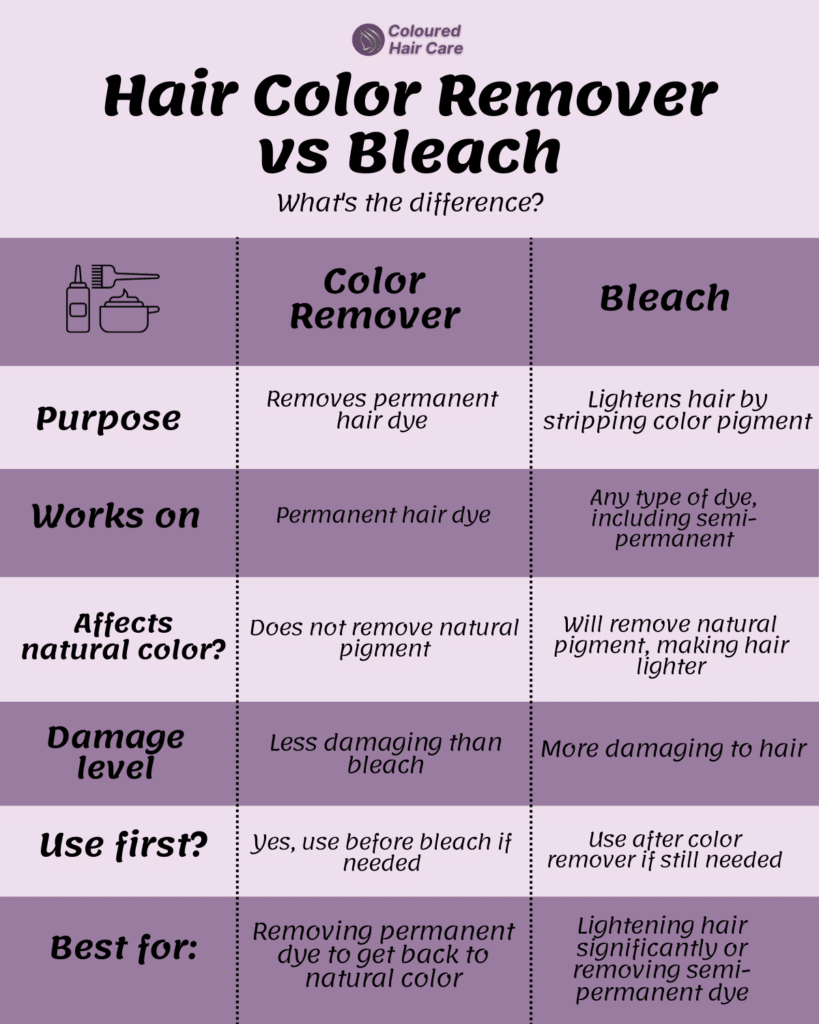What is the best way to remove dye from your hair? Should you use bleach or a color remover? This post will help you decide which one is right for you! Let’s talk about color remover vs bleach!
Many people struggle with knowing which one to use.
It can be hard to know what product will work best for your hair type, but don’t worry because we’re here to help!
In this blog post, we are going to cover everything you need to know about these two products so that you can make an informed decision as well as avoid any potential hair mishaps.
So let’s get started!
As an Amazon Associate, I earn from qualifying purchases.
Table of Contents
- If you want to remove hair dye.
- If you want to remove hair dye AND lighten your hair.
- What’s the difference between hair color remover and bleach?
- Color remover
- Bleach
- Which one should I use?
- Do you use color remover or bleach first?
- Hair color remover before and after.
- Bleached hair before and after.
- How bad is color remover for your hair?
- How bad is bleach for your hair?
- TOP TIPS
- Which is safer to use, color remover or bleach?
- Which is the best hair color remover?
- How does it work?
- How to use hair color remover step-by-step.
- Which is the best hair bleach?
- How to use hair bleach step-by-step.
- The verdict: Should I use color remover or bleach?
- Hair color remover FAQs
- Is color stripping the same as bleaching?
- Color stripping vs bleach.
- Is color remover the same as bleach?
- Can you bleach your hair right after stripping it?
- Does color remover remove bleach?
- Color remover or bleach bath?
- Parting words.
If you want to remove hair dye.
Use hair color remover.
If you want to remove hair dye AND lighten your hair.
Use bleach.
What’s the difference between hair color remover and bleach?
If you’ve ever bleached your hair at home, you probably know that it’s a lot of work to get it right.
You need to use gloves; apply it evenly; make sure not to leave it on too long or else you’ll end up with brassy hair; wash it all out and then condition like crazy!
If this sounds like a nightmare (or if you don’t even want to touch the stuff), there’s another option. Color removers.
While the chemicals in removers are less harsh than bleaches, they’re also more expensive products and can be hard to track down.
But what’s the difference between them?
“Bleach will take out your natural hair color, and hair color remover removes color that you’ve added to your hair. They do pretty much do the same thing, except, ‘haircolor remover’ works best when a “chemical oxidation” took place in the procedure last used to color your hair. In other words if you used a product which caused oxidation to occur during the application of the haircolor, as in permanent haircoloring, you can use a color remover to get rid of it.”
Paul Eliades, Studied Cosmetology at Western Beauty Institute

Color remover
- Is designed to break down the peroxide bonds of permanent dyes, allowing the color molecules to be rinsed out.
- They remove color build up and can be used more than once to get the right effect.
- They’ll get you back to your natural hair color, but won’t remove it.
- They DON’T remove direct dyes (semi and demi-permanent).
Bleach
- Is used to strip color pigment from your hair and give a lightened base to dye over again.
- It will remove ALL color from your hair, even your natural pigment.
- It can leave hair dry, damaged and looking brassy!
- It CAN remove any kinda dye.
Which one should I use?
A good rule of thumb when deciding which product to use is:
If your hair has been dyed with permanent hair dye, it’s safe to go with removers.
But these won’t remove semi-permanent hair dye, henna hair dyes or your natural color.
If you have dyed your hair with semi-permanent color, henna hair dye or you want to strip your natural color, then bleach may work better for you.
Do you use color remover or bleach first?
This is a classic beauty dilemma that leaves people torn between two camps.
If you go with the former, it could take up to 10 rounds of hair removal before your natural color comes through and if you choose the latter, well…you might end up with damaged tresses. So what should you do?
- You should always go with the remover first, to get rid of any unwanted pigmentation in your hair.
- If there’s still some color left over after that step, then by all means use a bleach product next.
This process will leave your hair feeling dryer than usual because there isn’t any natural oil left in it anymore due to the removal of its original pigment during either process – so don’t forget conditioner!
And finally, remember that both processes involve chemicals that could potentially damage your hair over time if done incorrectly or too frequently without proper care between sessions.
Hair color remover before and after.
Bleached hair before and after.
How bad is color remover for your hair?
Hair color removers are fabulous at stripping your locks of any color, leaving them a blank canvas for you to start over with.
But is this really something we should be doing every time we want a new look?
If you’ve ever dyed your hair and then tried to remove the hair dye, you’ll know that it’s pretty much impossible to get the color out completely.
So you end up repeating the process over and over again until more of the pigments are removed – which means more damage for your hair in the long run!
It strips out everything from your locks including any natural oils or moisture which can lead to dryness, breakage, and even split ends if left untreated after stripping away color.
How bad is bleach for your hair?
There’s no denying that bleach is bad for your hair. It’s a harsh chemical that can strip away your hair’s natural oils, causing it to become dry and brittle.
Bleaching can also damage the cuticle, making your hair more susceptible to breakage. However, some people argue that bleach is no worse than color remover.
According to some experts, bleach is actually less damaging to your hair than color remover. This is because bleach only affects the outer layer of your hair, while color remover penetrates the cortex, causing more damage.
So, if you’re trying to decide which substance to use on your hair, bleaching may be the lesser of two evils.
The trick when using either one of these methods is to give your hair extra TLC before, during and after the color removal process.
TOP TIPS
- Make sure you rinse out the product really well.
- Seal the hair shaft with a blast of cold water.
- Use a deep conditioning treatment two days before and straight after processing.
- Always use a heat protector spray before drying and styling.
- If you can, wait a couple of days before dyeing your hair again.
- Use a good toner to cool down any warm tones left in your hair.
- Get regular trims to get rid of split ends and keep hair looking healthier.
Which is safer to use, color remover or bleach?
When it comes to safely removing hair color, deciding between color remover and bleach can be tricky.
Sure, both methods can help you get rid of unwanted color, but which is actually safer for your locks?
The answer is color remover!
Unlike bleach, color remover does not weaken hair, nor does it require as much processing time as traditional bleaching.
It’s also more efficient at removing multiple colors and dyes in one sitting than bleaching – meaning fewer trips to the salon for touch-ups!
Color remover has become a go-to hair treatment for anyone looking to change up their look without damaging their tresses.
Which is the best hair color remover?
Color Oops Extra Conditioning Hair Color Remover.

How does it work?
Color oops can help you fix your hair color mistakes. Basically, Color Oops works by breaking down the molecules of the hair color, so that it can be rinsed away.
This means that you can go back to your natural hair color, or choose a new color altogether. And the best part is, it’s gentle enough to use on all hair types.
Here’s how it works: you mix up the two solutions that come in the kit, apply them to your hair, and then wait 30 minutes. After 30 minutes, you rinse out the solution (lots of lots of rinsing) and shampoo your hair as usual. The whole process took us about an hour from start to finish.
So, what was our experience like? In a word: mixed. The good news is that Color Oops did remove the unwanted pink hair color from our blonde hair really well. The bad news is that it also made our hair feel very dry and brittle.
We had to use a lot of conditioner to get our hair back to its normal state. But look, all color removers are drying, so the fact that this took out all the unwanted dye is good enough for us. Job done!
How to use hair color remover step-by-step.
Here’s a really good video that shows you how to use Color Oops at home.
Which is the best hair bleach?
Schwarzkopf BlondMe Bond Enforcing Premium Lightener 9+

How does it work?
Oh my word, this stuff is strong. DO NOT use this if your hair is fine, dry or brittle already as it will fry it off! This is what the professional use to lighten hair a few levels, so BE CAREFUL when using this bleach.
Here’s what you need to know about using it. First, you need to mix the powder with developer according to the instructions on the packaging. Next, apply the mixture to your hair, making sure to cover all of the areas you want lightened. Once you’ve applied the mixture, leave it on your hair for the recommended amount of time (usually no more than 30 minutes). Finally, rinse your hair and enjoy your new lighter locks!
So why is this so good at lightening hair? One reason is that it contains hydrogen peroxide, which helps to lift pigment from the hair shaft. So it zaps all the dye molecules, and your own natural color, with ease.
Of course, it’s a damaging process for your hair to go through, so you’ll need to give it lots of TLC before and after treatment. But if you have dark hair and want to lighten it to blonde, this is the one to use.
How to use hair bleach step-by-step.
The verdict: Should I use color remover or bleach?
There’s no reason you can’t use both, if you’re careful and take care of your hair.
You can always start off by trying a remover and see how that turns out.
Don’t expect a perfect white hair base.
You’ll likely end up with warmth in your hair and tones of red or orange from left behind pigment.
Remember you’ll be dyeing your hair again so don’t worry.
Just take it into consideration when you pick your new hair dye color.
And you can always use toners to cool it down and correct the color.
Hair color remover FAQs
Is color stripping the same as bleaching?
Have you ever wondered how to get shiny, healthy hair without the use of harsh chemicals?
Well, we’re here to tell you how it is possible. It’s a technique called color stripping and it’s all about removing color build-up from your hair.
There are so many different terms and techniques that can be used to describe the same thing, which can make things confusing.
Let us help clear up any confusion by explaining exactly what color stripping means and how it differs from bleaching your hair.
Color stripping vs bleach.
Color stripping is when you remove all of the natural pigment in your hair before applying new color or lightener to achieve a lighter shade than would have been possible with just one application of dye or lightener.
Bleaching involves using hydrogen peroxide mixed with ammonia to remove all pigmentation in your hair. It leaves a good base to add color or lightening agents afterwards to achieve an even lighter shade than was possible after removing all pigment through color stripping.
Is color remover the same as bleach?
While both products lighten your hair, hair color remover works very differently to bleach.
Hair color remover uses chemical reactions to shrink the color molecules in your hair, making them easier to wash out.
Bleach, on the other hand, uses a more aggressive chemical reaction to literally strip the color from your hair.
So which one should you use? It all depends on your hair type, current color, and desired result.
If you’re feeling unsure, don’t hesitate to seek advice from a professional stylist first!
Can you bleach your hair right after stripping it?
It’s not good idea to bleach your hair right after stripping it.
You can bleach your hair twice in one day. But just because something is possible doesn’t mean it’s a good idea for everyone!
The color will probably come out better and you’ll be able to get all of that hair dye in one go.
The downside is that you’re going to have some major breakage and damage from the chemical process so soon after stripping your hair.
You don’t want to bleach your hair too often. You might want to wait at least a week or two before attempting to bleach or dye your hair again because it could lead to damaged ends.
If you’re unsure, ask your hairdresser.
They can make an assessment based on how much color you’re trying to remove and the condition of your hair.
Does color remover remove bleach?
You can’t use a hair color remover on bleached hair since bleach isn’t a color!
Hyrodgen peroxide lightens your natural pigment by breaking up its molecules.
So it removes color, not the other way around!
Color remover or bleach bath?
If your hair has been dyed many times, or you’re trying to remove a particularly stubborn color like black hair dye or blue, you could try a bleach bath.
A bleach bath or bleach wash is a kinder way to use bleach.
It mixes hydrogen peroxide with shampoo to dilute the strength. Making it gentler on your hair.
If you don’t think removers will be strong enough but you don’t like the idea of strong chemicals, a bleach bath process could be for you.
Parting words.
If you’re looking to remove dye from your hair in the near future and are wondering what’s best for you, bleach or a remover is up to personal preference.
Bleach will lighten your hair more quickly but also has its downsides like it can damage your hair if not done correctly.
A color remover won’t change the texture of your strands as much as but can take longer than expected depending on how dark they were dyed beforehand.
Ultimately, it depends on where you want to go with this! We hope that our blog post helps clarify which option may be right for you! Good luck!

